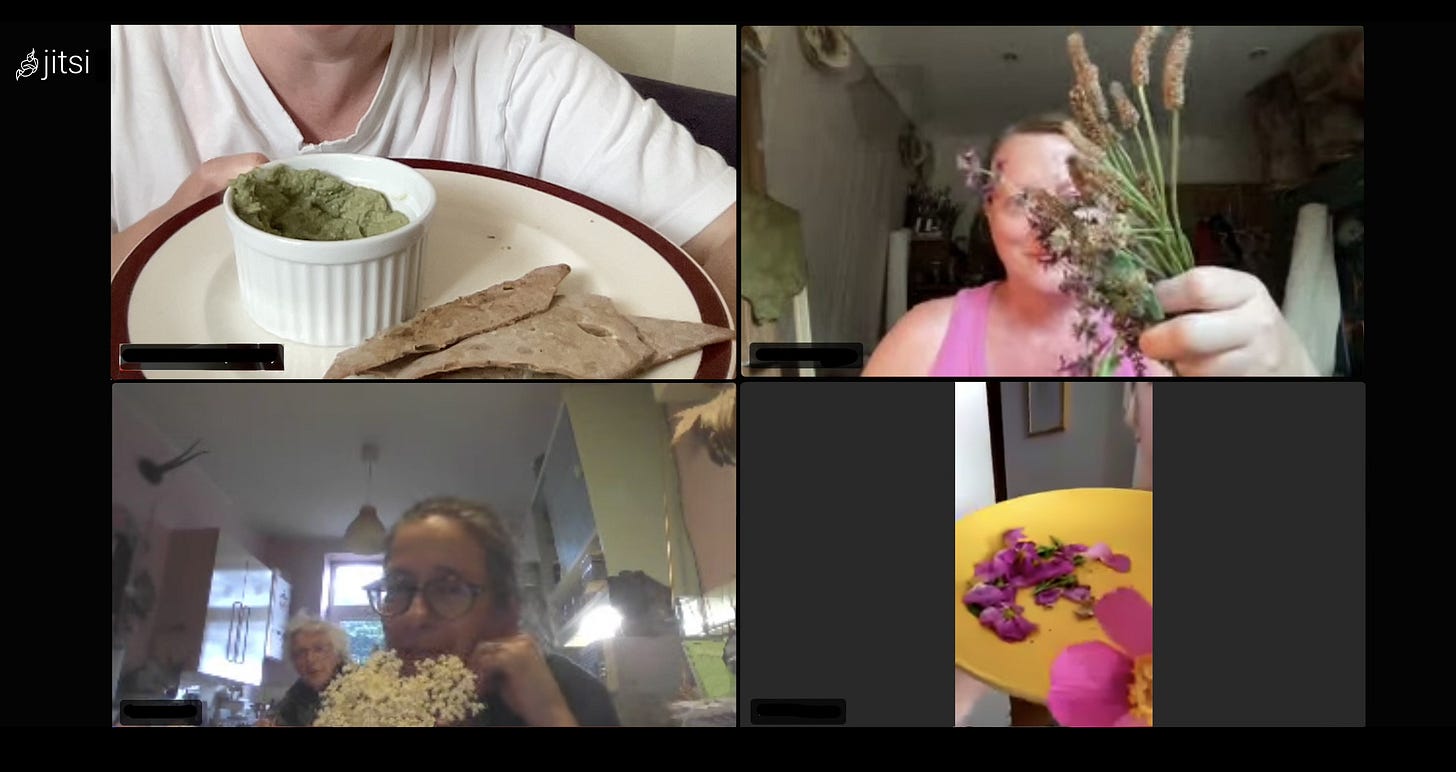Wild Tea, Land and Memory
A summary of June’s Commons Feast on wild plants, colonial legacies, and the right to roam
Thanks so much to everyone who joined the Commons Feast Virtual Monthly Meet-up last Tuesday, 17 June. We had a great discussion that encompassed stories, knowledge and reflections on wild food, land access, and personal connections to place. From the sensory pleasures of rosebay willowherb tea and Alberta wild roses to deeper conversations around our relationship with land, colonial legacies, access rights, and foraging laws, the discussion meandered through memory, history, and practice.
We started off by sharing our knowledge and practices around rosebay willowherb or fireweed Chamerion angustifolium. One participant in the south east of England had started to see it emerging on a disused railway line and wondered when the best time was to pick leaves to make Ivan Chai or Koporye tea. Luckily another participant had experience of doing this, still having a jar of the fermented, rolled-up leaves from 2020, the flavour of which she thinks might improve with maturity. Ivan Chai was a popular tea across Europe and further east. In the UK it was popular until the trade in Chinese and Indian teas with caffeine took over. With the rise of the Industrial Revolution and wage labour, drinks that combat tiredness were helpful for capitalism providing stimulation and dulled hunger pangs in the long hours of work in factories. According to one participant, the consumption of Ivan Chai tea goes back even further, having been found in a vessel at a dig site in Azerbaijan thought to be 3,000 years old.
Mo Wilde, in her new book, Free Food: Wild Plants and How to Harvest Them outlines the process of creating it:
“Scythe the Willowherb at the end of June, just before it flowers. Strip the leaves off and leave them in a heap on a sheet in the sun for a few hours until they start to wilt. Check on them regularly as you do not want them to dry to a crisp but just to go limp. Then bring them inside. Invite some friends around for reinforcements and roll the leaves between the palms of your hands to make wiggly knots. Pack them down firmly into a jam jar and leave for five to seven days. They will start to ferment in their own juices. After a week, take them out and dehydrate or oven-dry them to stop the fermentation – otherwise they go mouldy. This now tastes more like a black tea.
I sometimes go one step further and then put the fermented leaves (in a mesh bag) into the smoker with some burning applewood chips. It's like a fragrant Earl Grey or, with oak woodsmoke, an Assam” (Wilde, 2026:256).
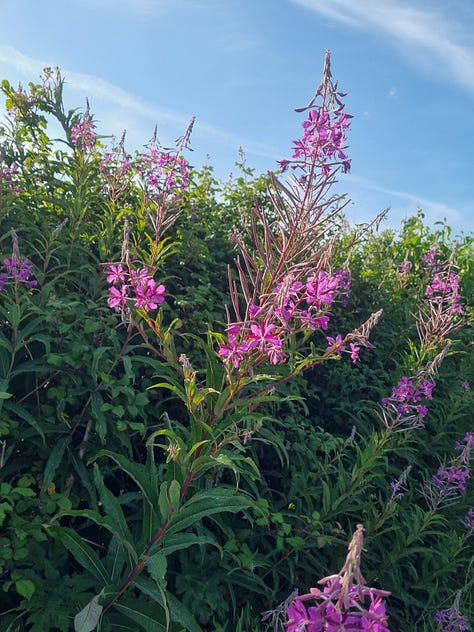
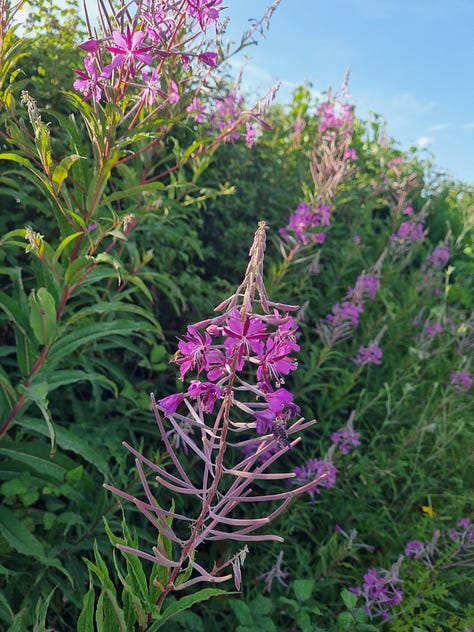
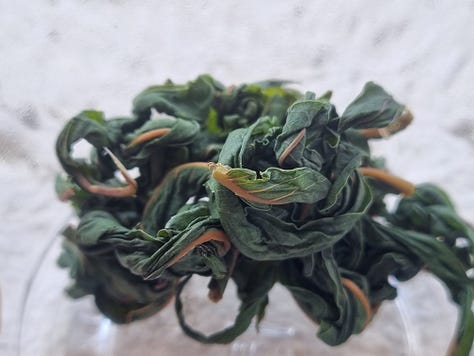
It was also suggested that mixing with dried rose petals is a lovely combination. This participant made their first batch in 2018. On pouring a cup for her husband, who is half Belarusian, one sniff transported him—Proustian-style—back in time to when he was a child and drank Ivan Chai tea, brewed in a samovar 24/7 on the Trans-Siberian Railway.
Our participant from western Canada feels she is only now catching up with foraging and experiencing the landscape through food and medicine, largely because phenological events in Canada are compressed, with nature going from dormancy to full bloom in a very short space of time after the winter. In recent weeks, there have been lots of rain and heat which has created the perfect conditions for everything to explode into life. For the first time she has picked the petals of the Alberta wild rose Rosa acicularis, the provincial emblem, which had just come into bloom. She was astonished by the fragrance and flavour, citing it as a deeply sensory experience “like licking someone wearing perfume” (Participant, 2025). She talked of how the petals can be used for teas, and the leaves for healing. In indigenous medicine, the leaves are chewed up and made into a poultice for wounds, burns, and bee stings. She had also picked a rosehip that had been left on the bush from last year, which prompted a discussion about this part of the plant's usage as food, medicine and in gameplay.
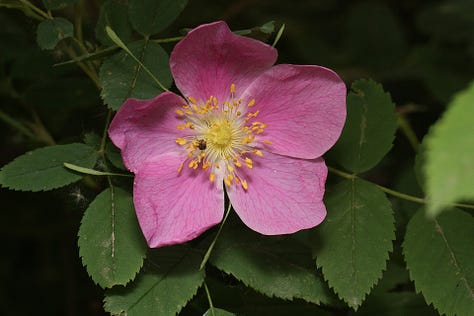
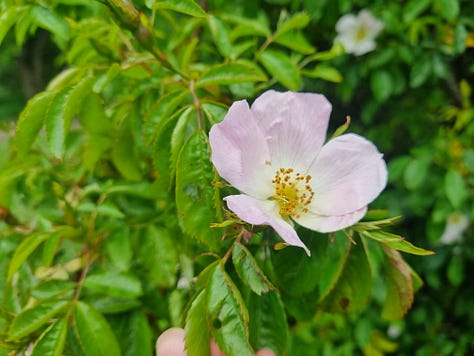
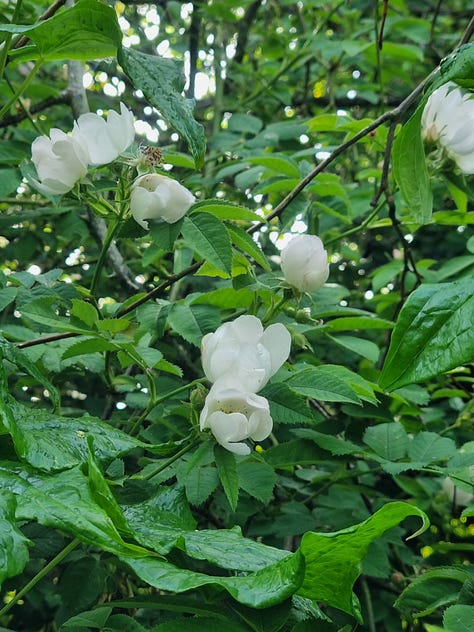
Suggestions were offered for different ways to make rosehip syrup. One participant’s favourite way is the infusion/sugar layering method similar to how she makes mugolio/pine cones syrup. I use the one from the Ministry of Food’s Hedgerow Harvest (1943). A discussion then ensued about the games being played with plants, for example, sticky weed and burdock burrs being thrown at clothing, the hairs of the rosehip that surround the small seeds – actually called achenes -- an itching powder --being put down the t-shirts of brothers, sisters and cousins, buttercups under chins, oozing out the milk from dandelion stems and one participant who was from restricted sugar, harvested their own sweetness by squeezing out the nectar of honeysuckle. Yet, a couple of us mentioned a fear instilled in us by our parents surrounding poisonous berries, likely caused by a lack of knowledge.
Our Canadian participant felt that picking the roses might be frowned upon even though it was in the back alley behind her house, which had likely escaped from a neighbour’s garden, and/or been transported from the wild. This feeling illustrated for her the many ways in which he has been separated from the land in her own country. Growing up as a white person on indigenous land, she had been instilled with a subtle but persistent sense of fear, an inherited perception that the land was somehow hostile or dangerous. This feeling, she suggested, was not coincidental but deeply rooted in a colonial mindset. She posited that settler descendants like herself often did not grow up with a sense of reciprocal relationship to the land. Instead, the land was framed as something to be controlled, extracted from, and used for food or industry although she recalled eating a lot of snow as a child, a simple sensory connection to the land, which contrasted with the simultaneous feeling of fear.
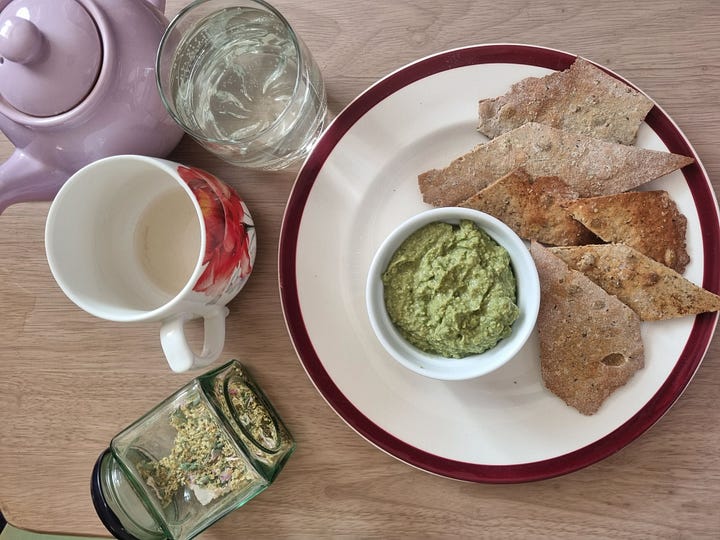
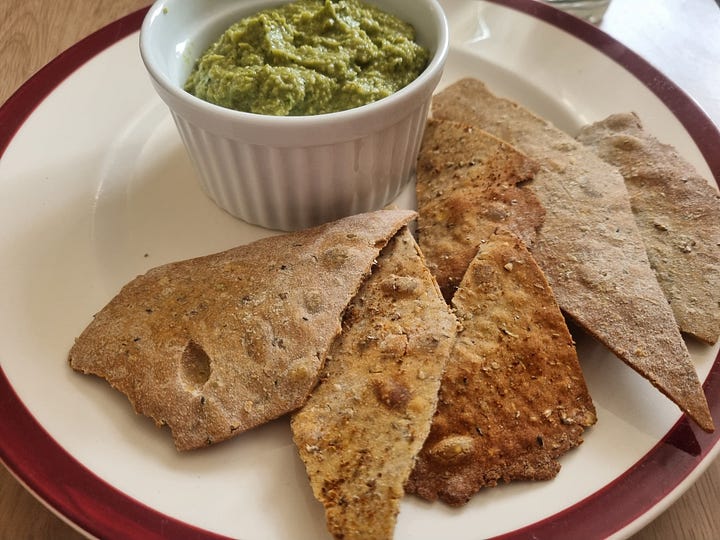
She shared with the group the complex legislation across the country, which often prohibits foraging in National and Provincial parks. However, it is permitted to forage on Crown land and private land.
Similarly, albeit for very different reasons, those of us resident in England recognised that it feels like we are also disconnected from our landscapes, currently being excluded from many of the spaces around us, not having the right to roam, unlike Scotland. The Right to Roam campaign is working to expand public access to nature across England, seeking to reform current laws. Currently, access is limited by the Countryside and Rights of Way (CRoW) Act 2000, which grants public access only to certain types of land, mainly open moorland, mountain, heath, and downland, which covers just 8% of England. We do have a vast, yet, diminishing network of footpaths, bridleways, and byways, but again, access is unevenly distributed, and often one is only able to pass through, not simply be in these spaces. These paths are also under threat: “over 49,000 miles of historic paths have disappeared from the official maps [and] 32,000 rights of way have been blocked or obstructed” (Right to Roam Campaign, 2025).
Our foraging law can also be quite complicated. John Wright in Hedgerow (2010) summarises it effectively:
1. You need permission to go on to land you do not own, otherwise you will be trespassing. This does not apply in Scotland.
2. There is a common law right, enshrined in law, that you may collect "fruit, flowers, fungi and foliage', providing it is for personal use only and is growing wild.
3. Byelaws exist in some places which have removed these rights.
4. This right does not exist on CROW land unless it existed before the land was registered under the act.
5. It is illegal to uproot any plant without permission from the owner of the land on which it grows.
6. Some (rare) plants are protected by law.
7. Plants cited in the declaration of an SSSI are protected.
8. Picking any plants on an SSSI may, strictly, be illegal but it is unlikely that picking common plants such as blackberries and sorrel will result in prosecution” (Wright, 2010:29).
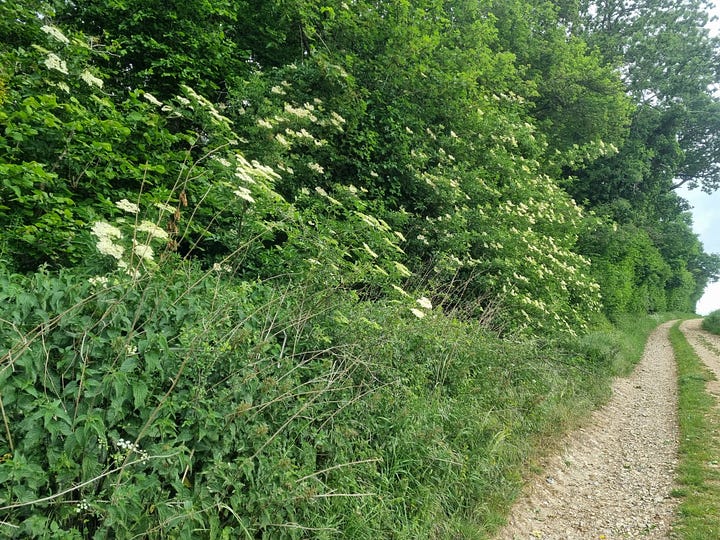
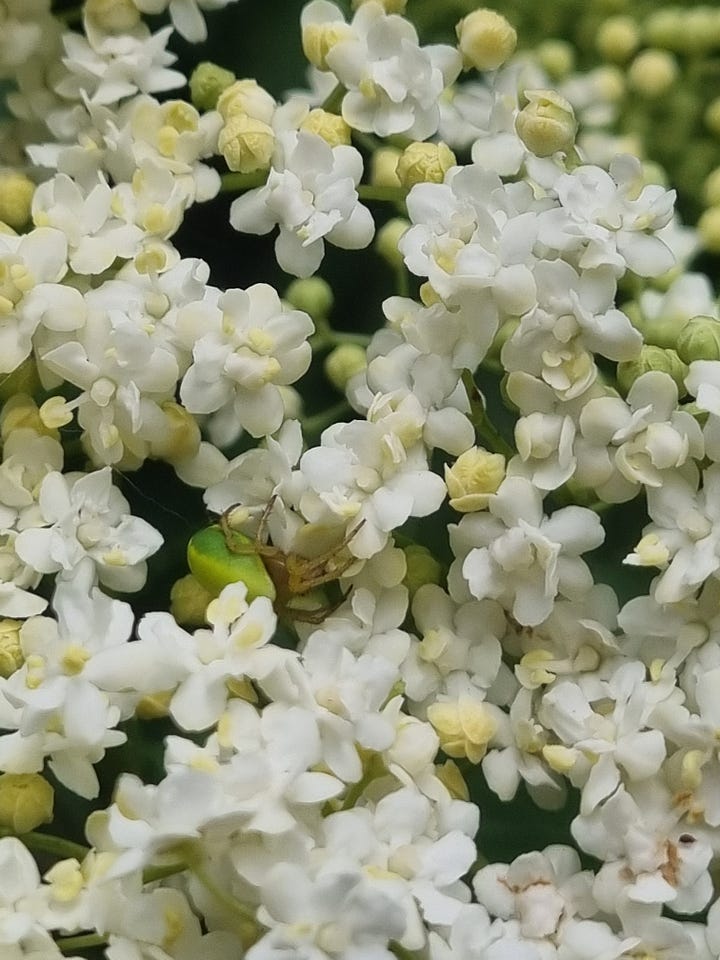
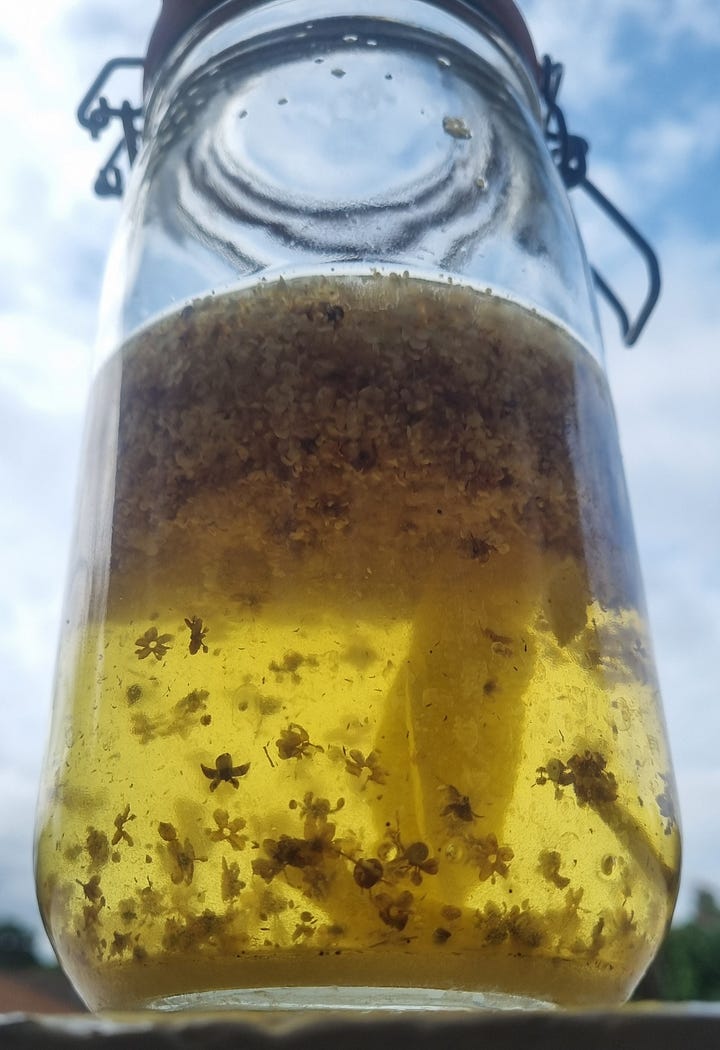
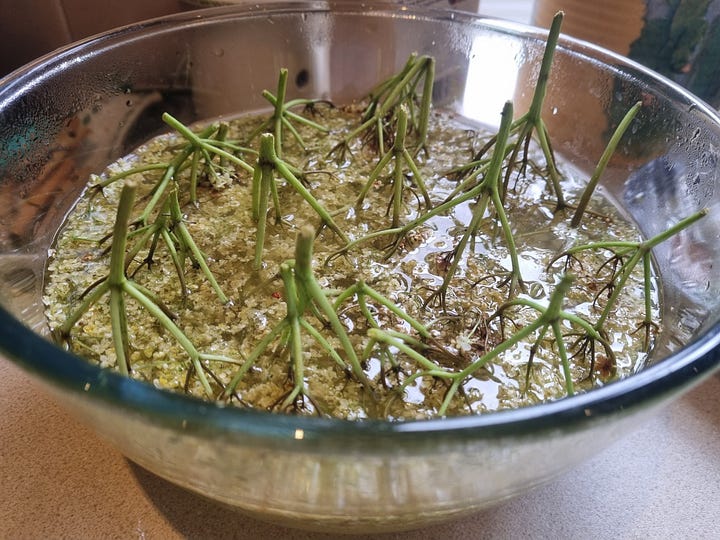
Finally, elderflower Sambucus nigra was on the menu again this month, and had been collected to infuse gin, make cordial and dry for a winter colds tea mix, alongside yarrow and peppermint. People have been eagerly awaiting the blooming of meadowsweet Filipendula ulmaria, which has yet to make an appearance.
References:
BBC (n.d.) Woman’s Hour food + cooking recipe archive: Recipe 93. At: https://www.bbc.co.uk/radio4/womanshour/food/recipe93.shtml (Accessed 22/06/2025).
Right to Roam (2025) Home | Right to Roam. At: https://www.righttoroam.org.uk (Accessed 22/06/2025).
Wilde, M. (2025) Free Food: Wild Plants and How to Harvest Them Simon & Schuster
Wright, J. (2010) Hedgerow Bloomsbury.


